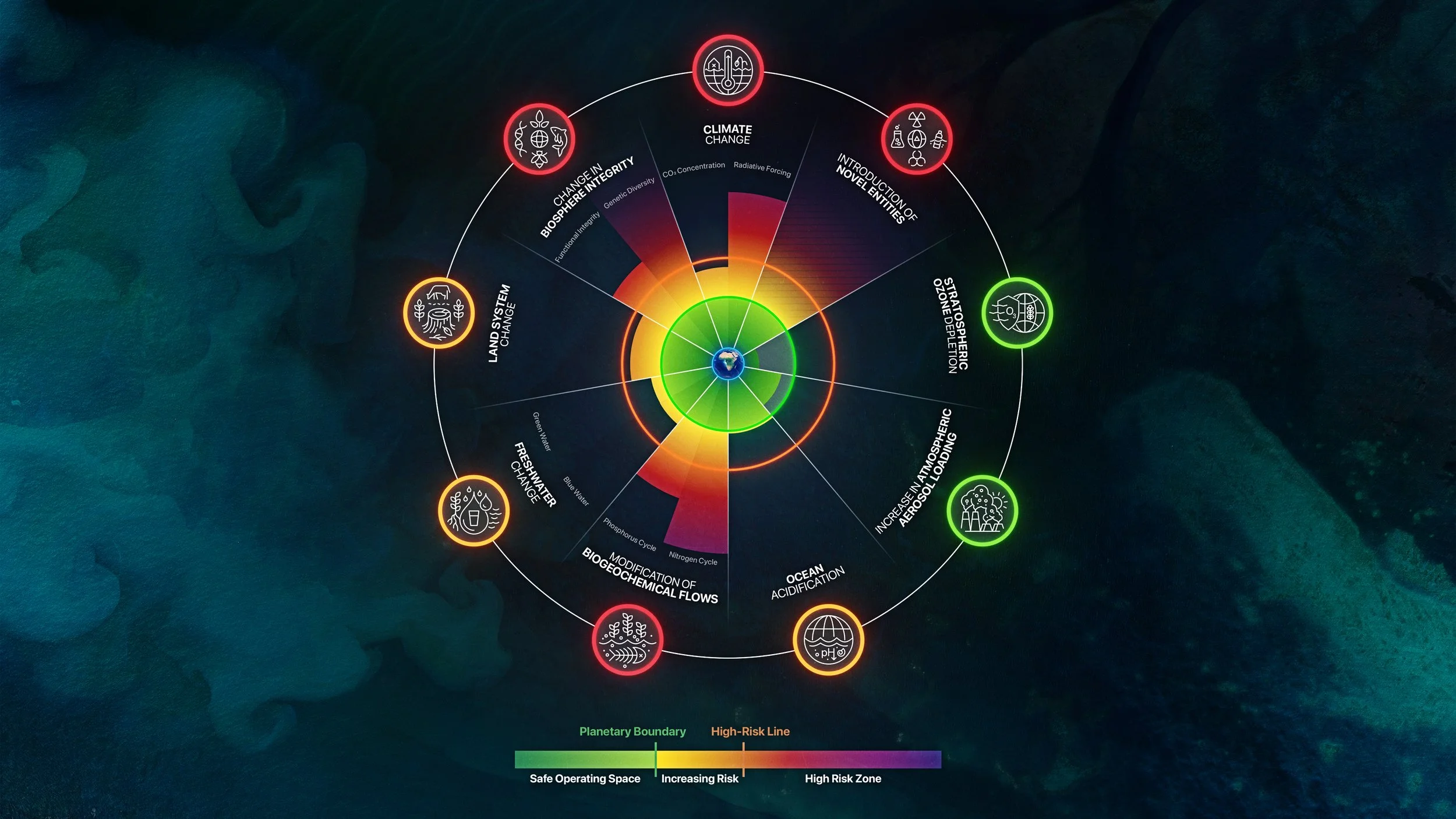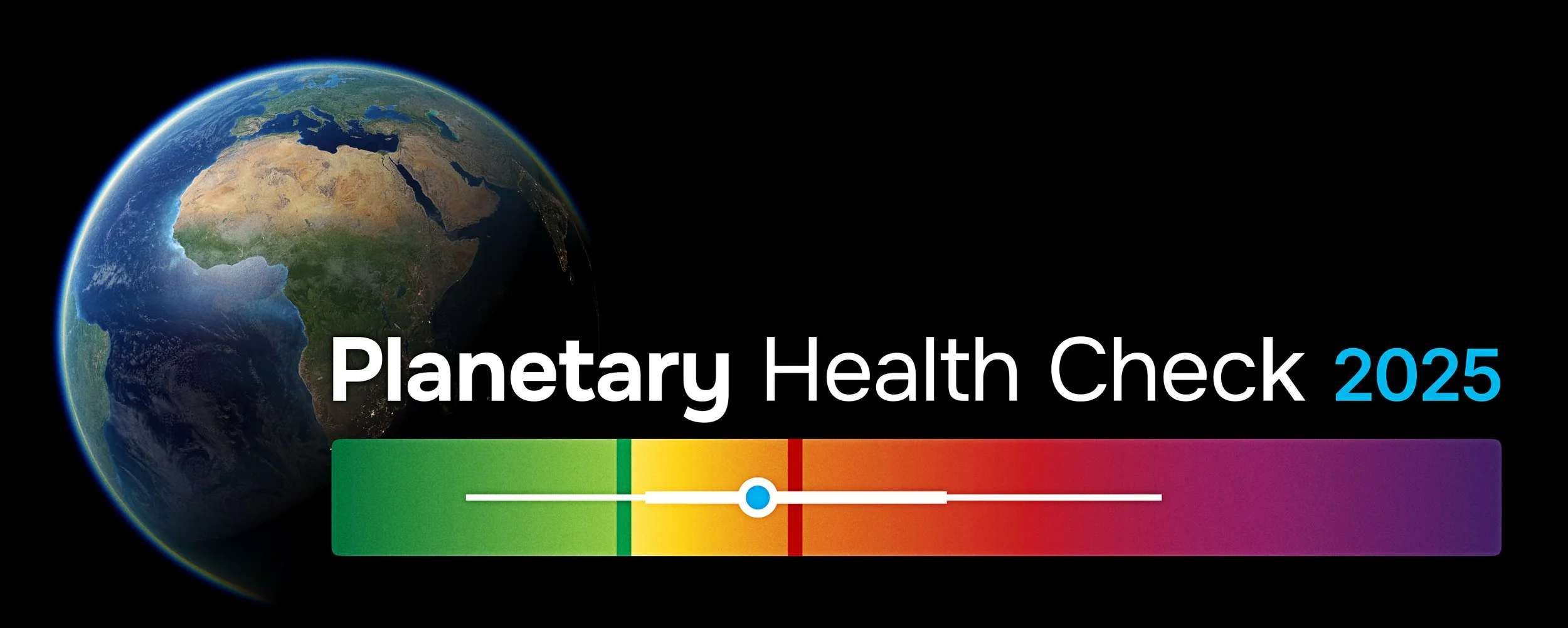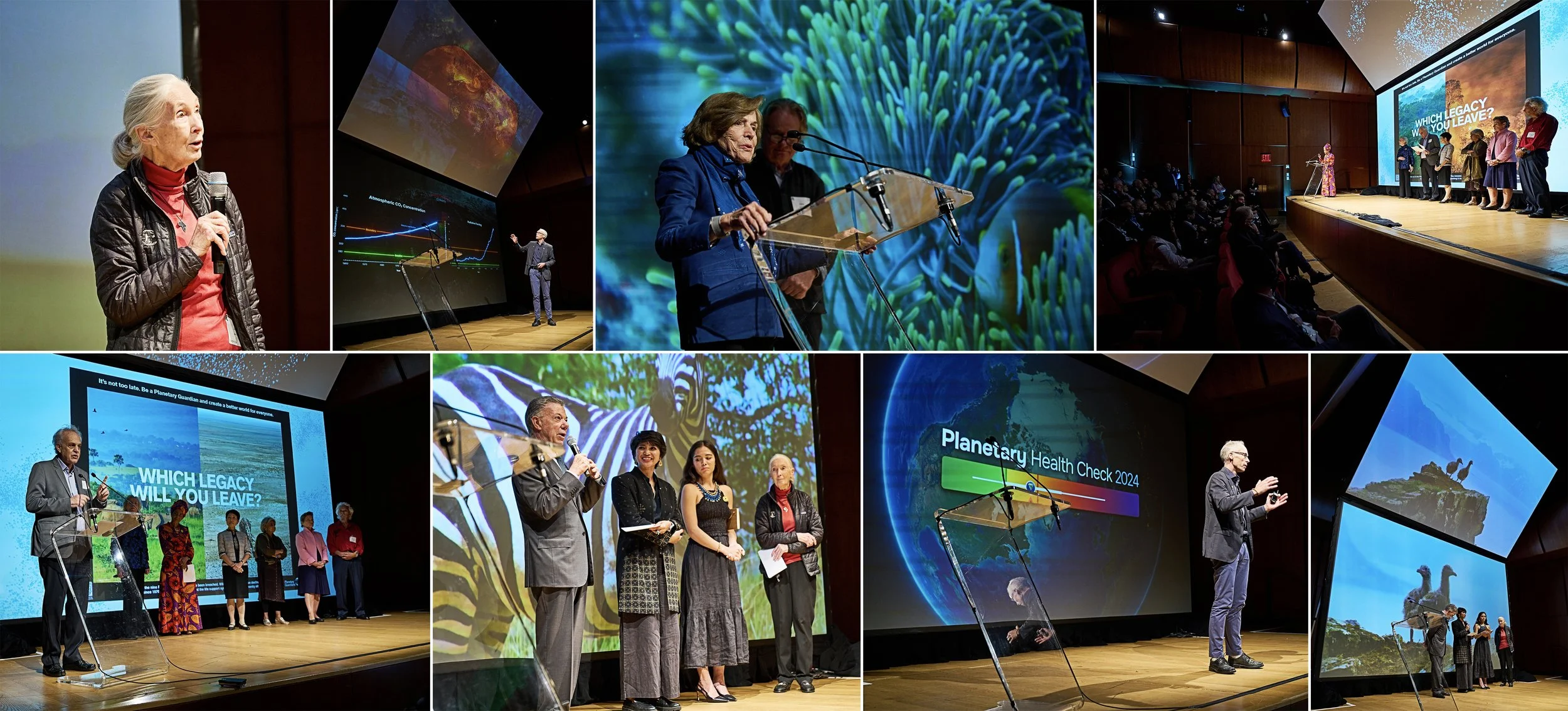
🌍🩺
Planetary Health Check
Potsdam Institute for Climate Impact Research · Planetary Boundaries Science
Planetary Guardians · Global Commons Alliance
Throughout 2024 and 2025, we had the honour of collaborating with the Planetary Boundaries Science team at PIK on the inaugural Planetary Health Check report. Our role included creating a visual identity for the initiative, as well as the figures and artworks to communicate the science behind this pioneering planetary diagnosis.
Written for a general audience and based on peer-reviewed research, the Planetary Health Check is built on the 🌍🚧 Planetary Boundaries framework and will be updated annually to guide societies toward a safer, fairer, and more sustainable future. Launched during Climate Week 2024 in New York City, the Planetary Health Check reached a new milestone with the release of its second edition in September 2025.
👉 Official website: www.planetaryhealthcheck.org
Special thanks to Johan Rockström, Levke Caesar, Boris Sakschewski, Niklas Kitzmann, and Jean Oelwang.






The Planetary Health Check Symbol
This symbol summarizes the 13 control variables used to assess the 9 Planetary Boundaries in a single visual. After several exploratory designs, iterations, and discussions with PIK’s scientists and the Planetary Guardians, we collectively decided to adopt the box plot approach, based on Dr. Boris Sakschewski’s suggestion, for its simplicity and elegance.
The gradient illustrates the different domains of the classic Planetary Boundaries diagram: in green 💚, the Safe Operating Space, representing Holocene-like conditions conducive to human civilization as we know it—characterized by its stability, resilience, and habitability; in yellow ⚠️, the Increasing Risk Zone, where tipping points are more likely to occur and which we should aim to avoid; and in red to violet ❌, the High-Risk Zone, a clear departure from the conditions in which humans and the biosphere have thrived for the past 10,000 years or so.
The thinner white line represents the status of the minimum and maximum values of the 13 control variables, in this case, Stratospheric Ozone Concentration and Nitrogen Use Rate, respectively. The thicker white line indicates the range where 25% and 75% of all assessed control variables are positioned. The indicator with the Earth represents the 50% value.
As of 2024, the current diagnosis indicates that we are in the Increasing Risk Zone and rapidly moving toward the High-Risk Zone. This should serve as yet another wake-up call for populations worldwide to continue exerting pressure on their governments to enact systemic changes in order to preserve our planet’s stability, resilience, and habitability.
We offer the Planetary Health Check Symbol in a variety of languages.
Contact us for corrections or specific versions.
Planetary Boundaries Symbologic System
ClimateBiospherePollutionNutrients (P/N)Land UseAerosolsOzoneFreshwaterOceanThe Planetary Boundaries framework outlines a science-based “safe operating space for humanity” to avoid severe, large-scale, and irreversible environmental shifts. Recent research shows that six of the nine boundaries have been significantly breached, with Ocean Acidification nearing its threshold.
The Great Acceleration, one of the key evidence of the Anthropocene epoch.
Ref: Steffen, W., Broadgate, W., Deutsch, L., Gaffney, O., & Ludwig, C. (2015). The trajectory of the Anthropocene: The Great Acceleration. The Anthropocene Review, 2(1), 81-98. https://doi.org/10.1177/2053019614564785
The 16 climate tipping elements of the Earth system.
Ref: Exceeding 1.5°C global warming could trigger multiple climate tipping points. Science. 2022
Humanity’s Journey on Earth, showing the ‘Corridor of Civilizations’ during the Holocene epoch.
Ref: J. Jouzel et al. Orbital and Millennial Antarctic Climate Variability over the Past 800,000 Years. Science 317,793-796(2007). DOI:10.1126/science.1141038 // Morice, C. P., Kennedy, J. J., Rayner, N. A., Winn, J. P., Hogan, E., Killick, R. E., et al. (2021). An updated assessment of near-surface temperature change from 1850: the HadCRUT5 data set. Journal of Geophysical Research: Atmospheres, 126, e2019JD032361. https://doi.org/10.1029/2019JD032361
Launch of the Planetary Health Check during Climate Week in NYC, September 2024.
Planetary Boundaries: A Short History
2009: The Birth of Planetary Boundaries
In the 2009 paper, the Planetary Boundaries framework introduced nine critical Earth system processes that are essential to maintaining the stability and resilience of the Earth system. These processes were identified based on scientific data regarding how human activities are affecting the planet. The PBs framework is rooted in Earth System Science (ESS) and Complex Systems Science (CSS), which study the interactions among different components of the Earth system, such as the atmosphere, biosphere, and hydrosphere.
At its core, the framework outlined boundaries—safe limits for human activity—that must not be transgressed to prevent large-scale, potentially irreversible environmental changes. It was an attempt to guide human development in a way that respects the planet’s ecological limits. If any of these boundaries are crossed, there is a significant risk of destabilizing the Earth system, which could undermine the stability and resilience of human societies.
Key Concepts Introduced in 2009
Safe Operating Space for Humanity:
This is the central concept of the PBs framework. It refers to a range of environmental conditions, akin to the relatively stable period of the Holocene epoch (the last 11,700 years), which allowed for the development of agriculture and human civilizations. Within this space, humanity can thrive without triggering large-scale changes in Earth’s system.
Thresholds and Tipping Points:
Each planetary boundary is associated with a threshold or tipping point. These are critical levels beyond which abrupt and possibly irreversible changes may occur. The tipping points represent the potential for crossing thresholds where feedback loops, like the melting of polar ice caps or the collapse of tropical rainforests, could lead to runaway changes.
Earth System Processes:
The nine Earth system processes identified in the original framework include:
Climate Change
Biodiversity Loss (Biosphere Integrity)
Biogeochemical Flows (Nitrogen and Phosphorus Cycles)
Ocean Acidification
Land-System Change
Freshwater Use
Stratospheric Ozone Depletion
Atmospheric Aerosol Loading
Introduction of Novel Entities (chemical pollution)
Interconnectedness of Boundaries:
The PBs framework emphasizes that these processes are interdependent. The transgression of one boundary can push other processes toward their tipping points, leading to cascading environmental effects.
Evolution of the Framework: 2015 Refinements
In 2015, the PBs framework was updated to incorporate new scientific insights and data. This revision deepened the understanding of some of the boundaries, particularly Biodiversity Loss (reframed as Biosphere Integrity to include both genetic diversity and ecosystem functioning) and Biogeochemical Flows.
2024: The Current State of Planetary Boundaries
The 2024 Planetary Health Check marks a new era for the PBs framework. This annual report, the first of its kind, assesses the state of each boundary based on the most recent data and developments. It highlights that six out of the nine planetary boundaries have been transgressed, posing increasing risks to Earth’s stability and resilience.
Insights from the 2024 Report
Six Boundaries Transgressed: As of 2024, six of the nine PBs have been breached:
Climate Change:
Atmospheric CO₂ levels and radiative forcing have exceeded safe levels, leading to unprecedented global warming.Biosphere Integrity:
The loss of biodiversity, both in genetic diversity and ecosystem functionality, is accelerating, with significant impacts on Earth’s resilience.Land-System Change:
Deforestation and urbanization are pushing the Earth past safe limits, reducing the ability of forests to act as carbon sinks and disrupting ecosystems.Freshwater Use:
Human use of freshwater resources is exceeding safe levels, leading to water scarcity and ecosystem damage.Biogeochemical Flows:
The nitrogen and phosphorus cycles are heavily disrupted by agricultural practices, leading to harmful effects such as ocean dead zones and soil degradation.Introduction of Novel Entities:
The release of synthetic chemicals, plastics, and genetically modified organisms into the environment is overwhelming Earth’s ability to cope with these pollutants, although exact figures remain uncertain.
Three Boundaries within Safe Limits: Despite this alarming trend, three planetary boundaries remain within the Safe Operating Space:
Ocean Acidification:
Though approaching a critical threshold, ocean acidification remains just within the safe limit.Atmospheric Aerosol Loading:
Aerosol levels have shown regional improvements, but remain a concern for global climate regulation.Stratospheric Ozone Depletion:
Global efforts to reduce CFCs have resulted in stabilization of the ozone layer, which is within the safe zone, though ongoing recovery remains fragile.
Tipping Points and Feedback Loops:
The 2024 report emphasizes the increasing likelihood of crossing tipping points in systems such as the Amazon rainforest, Arctic sea ice, and Greenland ice sheets. These tipping points are associated with positive feedback loops, such as the albedo effect, where melting ice reduces the planet’s reflectivity, causing further warming and more ice melt.
Drivers of Transgression:
Human activities, particularly those related to industrialization, agriculture, and fossil fuel use, are the primary drivers pushing the Earth system beyond safe limits. These drivers cause transgressions in multiple boundaries simultaneously, creating a complex web of environmental challenges that must be addressed holistically.
Solution Space:
A key aspect of the 2024 report is the emphasis on finding pathways to return to the Safe Operating Space. It highlights the need for transformative changes in governance, policy, and technology to mitigate environmental pressures. The creation of a Planetary Boundaries Monitor is proposed to provide real-time data on the health of the planet and to guide decision-making for global sustainability.
Concepts Introduced in the 2024 Planetary Health Check
Control Variables:
Each planetary boundary is monitored using control variables—quantifiable metrics that reflect the current state of each Earth system process. For instance, atmospheric CO₂ concentration and radiative forcing are the control variables for Climate Change.
Safe and Just Operating Space:
The 2024 report also builds on the idea of a “Safe and Just Operating Space”, introduced by the Earth Commission in 2023. This concept integrates social justice into the framework, emphasizing that environmental sustainability must be coupled with equitable access to resources and minimizing harm to well-being.
Though not officially part of this project, this artwork is an allegorical interpretation the Planetary Boundaries framework.
It portrays our planetary home, Earth, in a fragile equilibrium atop Mount Stability. This mount represents the conditions similar to the Holocene epoch, during which human civilizations have thrived. These conditions, characterized by their stability, resilience, and habitability, have provided a ‘Safe Operating Space’ for humanity to thrive over the past millennia.
Supporting this balance are 9 pillars, symbolizing the 9 Planetary Boundaries that demarcate the biophysical conditions necessary for maintaining a stable Earth system.
In this illustration, six of these pillars are depicted in red as compromised or transgressed, suggesting that several critical Earth systems are under increasing strain. It reflects the current understanding that exceeding these boundaries could destabilize the conditions necessary for human well-being and the overall resilience of the biosphere.






























